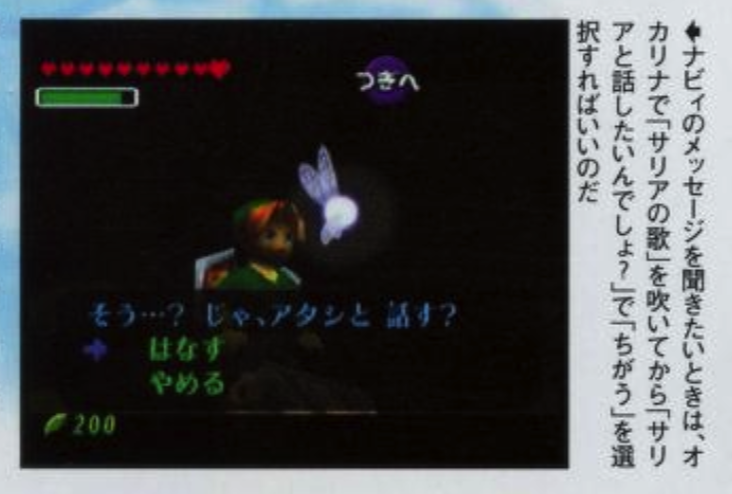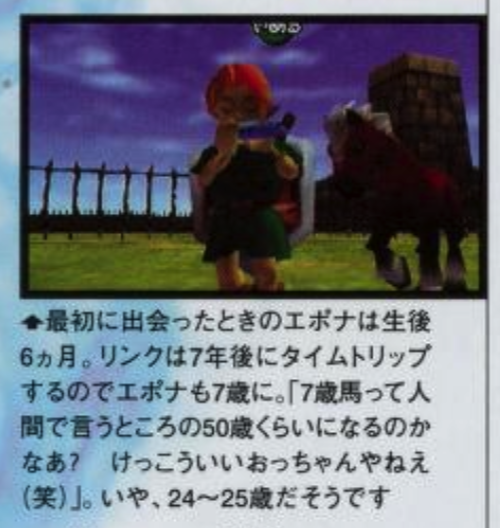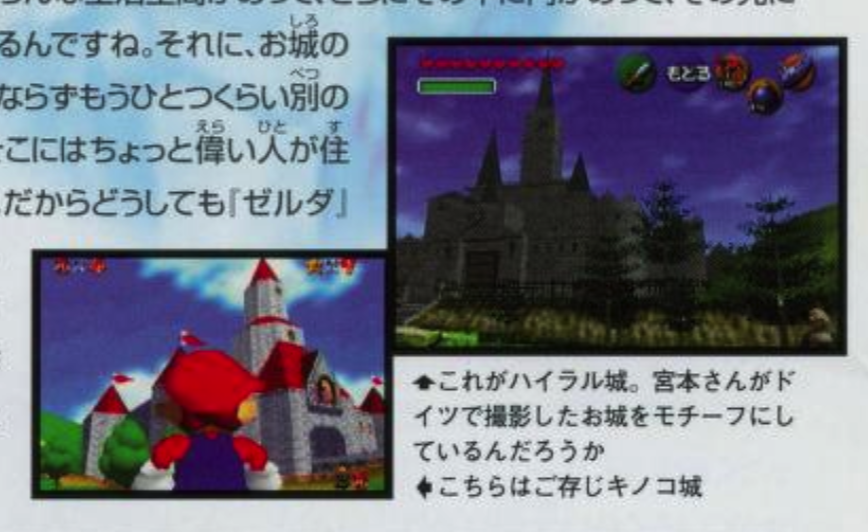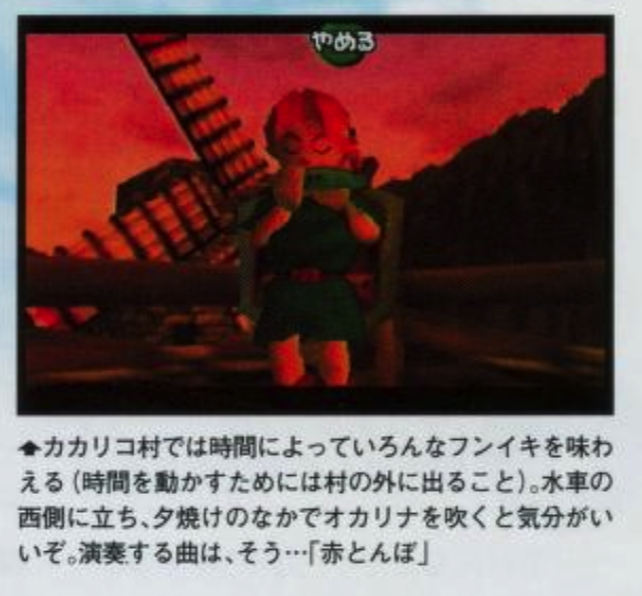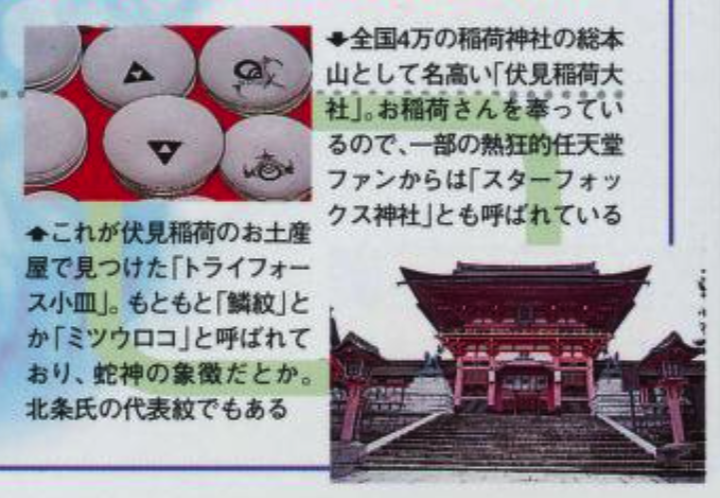This Shigeru Miyamoto Q&A was published in The 64 Dream issue #28 from 1999.
Archived magazine here: https://archive.org/details/64dream-january-1999-ozidual
Translated by
Roryj: https://twitter.com/RoryJWhelan
Formatted by
Javed Sterritt: https://twitter.com/JavedLSterritt
Please consider supporting to allow us to keep up the translation work: https://www.patreon.com/goodblood





We still have questions about Zelda!
Does the fairy, Navi, speak Kansai-ben (Osaka area dialect)?
Q. The first character you meet when you wake up is Navi. During the adventure, they’re giving advice, particularly in the English version of the game they call out saying “Hey! Listen” and “Watch Out”, however at E3 I’m pretty sure in Japanese they were heard saying “This way, This way!”.
Miyamoto: Since then, I've changed it to make it a meaningless line in English. Well, people who can speak English seem to understand “watch out,” but it seems to be heard in various ways. “Listen” sounds like “link,” and “watch out” sounds like “koccha” [Phonetically spelt Japanese word for “this way”] (laughs). At first, I thought “watch out” sounded like “old man.” I thought that was pretty cool (laughs).
When you want to hear Navi's message, play “Saria's Song” on the ocarina, then select ‘No’ when asked, “Do you want to talk to Saria?”
Were you inspired by The Unfettered Shogun [Japanese TV program] when designing Epona?
Q: Link gallops across the Hyrule Plains at night on Epona... many readers were moved to tears by the beautiful, poetic opening of Zelda, no doubt thinking, “I'm glad I waited for the release of the game without giving up...” I don't mean to rain on your parade, but it’s rumoured that the model for Epona was based on the horse that appeared in the opening of the historical drama “The Unfettered Shogun”.
Miyamoto: That’s a lie (laughs). I said something like, “Make the motion capture room a large studio that can accommodate horses” (laughs). I'm sure there are all kinds of stories mixed up there. I've seen lots of horses before, but the staff hadn't seen many. So, when there was an event where you could ride horses like at a traveling zoo on the riverbank, I went along with them. Among the people who let us ride the horses was a stuntman from Toei, and the horses they used were the same ones that appear in Toei films (laughs).
When they first met, Epona was six months old. Link travels back in time seven years later, so Epona is now seven years old. “I wonder if a 7-year-old horse is like a 50-year-old human. That's quite an old man (laughs).” Really, it's actually about 24-25 years old.
Hyrule Castle was modeled after an old castle in Germany.
Q: When you think of castles, you think of Mushroom Castle. It was such an unguarded castle that it felt inevitable that Princess Peach would be kidnapped, but Hyrule Castle in Zelda is quite different. The gates are reinforced and the security measures are foolproof. There is also a lively town below the castle, and even some back alleys. Why has it changed so much?
Miyamoto: Right after Mario 64 was finished, I went to Germany by myself. I attended a presentation and visited some castles and also bought lots of books. When we think of castles, we tend to imagine them standing alone on hilltops, but that's not actually the case. There are various types of castles, such as those built by the Jukyo (feudal lords) and those designed to keep enemies at bay. They are built to surround mountainous areas, with forests surrounding them to prevent intruders from entering. Inside the castle walls, there are various living spaces, and beyond the gates, the castle itself stands. Additionally, there is always at least one other building besides the castle itself, where someone of higher status resides. Therefore, in “Zelda,” I wanted to create a castle where those people live.
Right Caption: This is Hyrule Castle. I wonder if it was inspired by the castle that Miyamoto photographed in Germany.
Left Caption: This is the famous Mushroom Castle as you already know.
WHY KAKARIKO VILLAGE IS SO BUMPY
Q: There are many places in the new Zelda game that are fun just to walk around in. The atmosphere in Kakariko Village is especially great! You hear chickens crowing and cows mooing, which makes it feel very much like everyday life. It makes you think, “There used to be a village like this somewhere.”
Miyamoto: Up until now we've been working in the flat world of the NES [Famicom], so we tend to think about the flat layout of the area first, but real villages are different. When I watch TV programs or actually visit villages, I often see that many of them are located on slopes. There are fields, houses, and mountains in the background. So, in Zelda, we decided to create a village with ups and downs. So, the image I had in mind was terraced fields, a waterwheel, and a winding path leading down to a well at the bottom, but what actually ended up being built resembled the form of a staircase (laughs). But I thought, “This is good too,” and the designer made it on their own, which led to an interesting misunderstanding.
In Kakariko Village, you can experience different atmospheres depending on the time of day (to change the time, you need to leave the village). Standing on the west side of the waterwheel and playing the ocarina in the sunset feels great. The song we'll be playing is... “Akatonba. (Red Dragonfly)”
IMPORTANT FEATURES THAT MR. MIYAMOTO FORGOT
Q: Those who emerge from Kokiri Forest for the first time and find themselves on the plains of Hyrule will be amazed by its vastness. While enjoying the pleasant feeling of freedom for a moment, take a moment to look up at the sky. You will see the sun moving quickly, like a fast-forwarding film. Yes, this new Zelda game features the “flow of time.” Does that mean you can record the number of days it took you to clear the game?
Miyamoto: I forgot about that feature (laughs). At one point, there was a move to bring forward the release date of Zelda, and at that time, we were told that no further changes to the system were allowed. At the end, “THE END” would have displayed, a beep sounds, and “It has been XX days since leaving Kokiri Forest.” I also wanted to add, “Link's adventure is over for now...” but if I wrote “over for now...” then I'd have to make a sequel... (laughs). I tried to put that type of pressure on myself to include ideas like that, but in the end I wasn’t able to fully realize everything, and luckily I didn't have to make that sequel (laughs). But I thought it would’ve been a great idea.
The “Gossip Stone” tells you the time when you hit it with a sword. If you place a bomb next to it, something amazing will happen. It’ll turn into Chiaki Mukai [Japanese astronaut]. (Joke saying if you place a bomb it’ll be shot up into space)
The origin of the names “Zelda” and “Link”
Q: One of the most frequently asked questions in the “N64 Question Box” is, “What is the origin of Zelda's name.” When I asked Mr. Hongo, he replied, “Well, I don't know,” so I asked Mr. Miyamoto directly.
Miyamoto: I had already decided on the title “The Legend of Something or other,” so I consulted with a songwriter about it. They told me that the writer F. Scott Fitzgerald had a beautiful and famous wife named Zelda. “That’s a cool name!” I asked him,” do you think it’s okay if I use the name in place of Something or other?” he said “Sure!” and that’s how it became “The Legend of Zelda.” So there's no real special meaning behind the name “Zelda.” However, “Link,” “Impa,” and “Triforce” do have meanings. Link means “to connect,” Impa is from “IMPART,” meaning “to pass on,” and Triforce means “three powers.” So, we decided to give them meaningful interpretations, such as “the one who connects the three powers” and “the one who passes them on.”
I didn't know that the origin of “Zelda” came from the wife of Fitzgerald, who wrote “The Great Gatsby.” Her full name was Zelda Sayre, and she was said to be “the most beautiful woman in Alabama and Georgia.”
What’s the relationship between Triforce and Fushimi Inari?
Q: Actually, before interviewing you Mr. Miyamoto, I visited Fushimi Inari Taisha Shrine (a 10-minute walk from Nintendo). I made three wishes: “May Mr. Miyamoto's interview be a success,” “May Zelda sell well,” and “May 64 Dream also sell extremely well” (how humble). Then, when I stopped by a souvenir shop, I saw plates and jars with the familiar triangular mark everywhere! Is the Triforce related to the shrine?
Miyamoto: No, it has nothing to do with it. Gunpei Yokoi's [Inventor of Game & Watch and Control Pad] family crest was the same, but I only found out about that later. It was a complete coincidence. When we were first making Zelda, we were wondering what kind of items to use, and we decided that some kind of “triangle power” would be good, so that's how it came about. The design was the most beautiful and fit well.
Fushimi Inari Taisha Shrine, famous for the Matsumoto Mountain of 40,000 Inari shrines nationwide. Because it is dedicated to Inari, it is also called “Star Fox Shrine” by some enthusiastic Nintendo fans.
Bottom Caption: This is a “Triforce small plate” that I found among the souvenirs at Fushimi Inari. It was originally called “Tonari-mon” or “Mitsu-uroko” and is said to be a symbol of the snake god. It is also the representative crest of the Hojo clan.
Right Side Column: Of course, we'll do it again this time! 64 Dream’s Specialty, Yes or No Questions
(Circle = Yes, Triangle = Maybe/Sort of, X = No)
Q.I am 100% satisfied with the completion of “Zelda.”
A.“About 90%, I guess... Give me another two months (laughs).” △
Q.“Zelda” is likely to sweep the 1999 game awards.
A.“I'm not interested in that kind of thing.” X
Q.This Zelda project was the most challenging one I've ever worked on.
A.“It's always tough (laughs).” X
Q.If asked, I would have appeared in a TV commercial.X
Q.I often dream about work.X
Q.I think I'm lucky.〇
Q.I want to be involved in game development until I die.〇
Q.I want to make a game on CD-ROM
A.“I'm not interested in CD-ROM games, but the media is cheap.” 〇
Q.I want my children to enter the game industry in the future.
A.“Either yes or no is fine.” △
Q.I would like to be the president of Nintendo at least once.
A.“I don't want to do it even if you ask me. You're not going to ask me, are you (laughs)?” X
Q.Lately, there are times when I feel like I'm getting old.
A.“I feel dizzy... I guess that's not the case (laughs). Young people have become more cautious. The age gap is too wide.” 〇
Q.Sometimes I can't keep up with young people's conversations.
A.“That's not true... I think it's just that I'm getting old (laughs). Maybe everyone is just trying to accommodate me (laughs).” X
Q.I think games are art.
A.This is a deep discussion about what art is, but I think that popular culture will also become art in 100 years. However, I don't think it's the kind of art that is considered academic today. I think Mozart also wrote music while watching the faces of his audience. Well, I don't really know for sure (laughs). X
Q.If I were to be reborn in the same place and time, I would still choose to be Shigeru Miyamoto.
A.(After much deliberation) Yes 〇
Q.As a commander, I am more like Nagashima than Nomura.
A.“He's a nasty guy (laughs).” X
Q.Have you ever yelled at work?
A.“Hmm. Some people might think I'm being harsh. I do get angry sometimes, but it's on purpose. I think it's about time I got angry (laughs).” X
Q.There are many unusual individuals in the gaming industry.X
Q.The N64 became a huge hit with “Zelda.”X
A. “64 Dream will also be a big hit.” Editor: “We received the same comment last year (laughs).” 〇
I also asked Miyamoto about his future plans after completing Zelda.
Will “The Legend of Zelda DD” be released?
Q: Originally, “Zelda” was a software intended for 64DD. I'm happy that ‘Zelda’ is complete, but I still asked, “Will there be a 64DD version?”
Miyamoto: The buzz around the 64DD has been dying down a bit lately. That's because when you release a 64DD, you have to undergo all the PL (this could be Profit and Loss or Product Liability) and factory inspections. We haven't undergone those checks yet, so we can't promise to release it. However, this version of Zelda is designed to read data from the 64DD disc. I can show you now, but although the cutscenes and locations are all the same, once you enter the Deku Tree, you will find a completely different dungeon. We are considering selling the 64DD version as an ultimate challenge game for around 2,000 yen, but I cannot make any promises.
“We may release another Zelda game on cartridge in a year's time, and bundle it with the 64DD to include various features,” said Miyamoto. I'd like to try out the Deku Tree, where the dungeon changes every time you enter it, but...
Will there be a new game using the Zelda system [I think more akin to engine]?
Q: Rare's Perfect Dark, unveiled at this year's E3, was created using the GoldenEye engine. Using the same system has the advantage of allowing new software to be created quickly and cheaply. That being said, I would be delighted if you could use the engine from the upcoming Zelda game to create a game with different characters and a different worldview. What do you think Mr. Miyamoto?
Miyamoto: I haven't done that much before, but the engine for this Zelda game is designed to be versatile, so I think it would be a good idea to do so. I always start out saying that, but in the end I end up redoing everything... (laughs). The program development system also involves a large number of people, and we have created a system that allows multiple people to work on it at the same time, so I think it will work out pretty well.
How about “Star Fox's Great Adventure” for the next game? The dungeon inside Corneria looks fun, and you could travel back and forth in time with little Fox and adult Fox.
Of course, we’re still curious about Miyamoto's next work.
Q: The N64 games that Miyamoto was deeply involved in are Mario 64, Wave Race, Star Fox, 1080 and now Zelda, for a total of five titles. Can we consider this the end of the first step in the “Shigeru Miyamoto N64 Series”?
Miyamoto: No, my work on the N64 is far from over. There's also the Mario Artist series. Another producer is in charge of this software, but since I am responsible for assigning work, I can't say that I don't know anything about it, so I think this step will be finished once these projects are completed. Also, in the future, I want to create a game with a completely new mechanism that will change the image of games, rather than just stacking them up. Well, as the president said, it could be a three-dimensional development... It could be something like connecting the Game Boy to the 64DD and N64, or it could be something completely different... (waving his hands up and down) It could even be a cassette this long (laughs). In any case, I’m not sure what it will be.
This is the desk of Mr. Miyamoto, the head of the Information Development Division. There are stuffed toys of Mario and Donkey Kong, as well as a cool poster of “Zelda.”
What about games other than Zelda?
Q: Mr. Miyamoto leads a team of approximately 150 members in the Information Development Department. Since there were about 50 staff members involved in the development of “Zelda,” I wonder what kind of software the remaining 100 or so members are working on?
Miyamoto: Of course, other software lines are also constantly evolving. They are working on adjustments to F-ZERO DD, developing two completely new titles, and creating software that is an extension of Pokémon Stadium. We are also experimenting with Yoshi on both cartridge and 64DD. And there's more: we've made some progress on Mario 64-2, but it's on hold for now (laughs). I have to do it after I finish Zelda.
All Luigi fans across the country, let's play “Mario Party” for a while and wait for the completion of “Mario 64-2.”
I also asked about that software I was curious about.
Q: MOTHER3 and Mario RPG 2 consistently rank high in popularity polls. Although Zelda will be available to play shortly, it is also true that many users are eager to play these RPGs.
Miyamoto: The development of MOTHER 3 and Cabbage was mostly left to Mr. Iwata at HAL Laboratory. I would be in charge of “Mario RPG 2.” The biggest challenge is deciding which of “Mario RPG 2” and “MOTHER 3” to prioritize as the main focus for next year. As for the release date, I haven't even seen the games for about half a year since I joined “Zelda,” so I can't say for sure, but I think it's coming along quite well.
While conducting the interview, I found myself thinking the presumptuous thought, “I want to give Mr. Miyamoto a break after he finished such a big job” (photo shows Mr. Miyamoto playing the banjo).
1080° #2, which was scheduled to be released
Q: Looking at the flow of software that Miyamoto was deeply involved in, I noticed a pattern: after “Mario 64,” “Wave Race” was released, and after entertainment-oriented games, realistic games were always released. So does that mean that after Zelda, there will be a realistic game?
Miyamoto: Actually, there was a move to make “1080 2” this winter, but we put it on hold. From a sales perspective, it would be better to release a sequel and sell it, but we also thought that it would be good if the “1080” [snow]boards we are using this season were to be re-released this winter. To be honest, the 1080 team has already begun research on the next hardware.
I'm sure there are many people who want to play “1080 2” (if you haven't played “1080” yet, you should do so, since it's the season [winter]). But I'm also curious about the new hardware that will follow the N64, which is not the 64DD.
What Miyamoto thinks about online games
Q: The 64DD is scheduled to go on sale in June next year. This new hardware is supposed to be compatible with online communication (modem to be sold separately), but what does Mr. Miyamoto think about this feature?
Miyamoto: We have finally entered the planning stage. We are finally at the point where we can begin considering the details on site. In the past, as a game designer, I had to deliberately ask questions such as, “Who will maintain the infrastructure for communication?” However, now that everyone is discussing issues such as “How much will the phone bills be?”, there is no longer a need to ask such questions. That's why I'm telling the staff to “go back to the basics.” “Is online gaming really interesting?” “Is it okay that we can't see each other's faces?” “Can we chat using the current controller?” We're going to talk about these things properly from the game’s perspective. So, it may turn out to be something completely different from previous online games.
END OF INTERVIEW
What the pioneers aimed for
Becoming freer with Miyamoto’s games
To me, “Mario 64,” “Fox 64,” and now “Ocarina of Time” feel less like independent works and more like a series united by a single theme. If I were to give it a title, it would be something like “Shigeru Miyamoto's N64 Interactive Movie Trilogy.” When I asked Miyamoto about this, he replied that it was an overinterpretation and that it was not a conscious trend. However, even though the producer himself denied it, I still can't help but think that way.
Interactivity is not limited to these three games, but is a theme that runs through all of Miyamoto's games. However, only these three games can be called interactive movies. Summarizing Mr. Miyamoto's previous statements, the definition of interactive movies is “not a passive experience like watching a movie, but rather one in which users actively participate in the game and complete their own stories.” Even if you spend the whole day riding a horse or practicing the ocarina in the same place and end up not seeing the ending, it is still an interactive movie in its own way. Various events and items appear in “Ocarina of Time,” but most of them are not set as prerequisites for seeing the ending. This is because the developers want users to complete “their own stories.” In the huge box garden called Hyrule, users are completely free to do whatever they want.
Having completed three games with slightly different degrees of freedom, I now feel strongly that “Ocarina of Time” is not the culmination of Shigeru Miyamoto's interactive movies for the N64, which focused on the theme of freedom, but rather a new first step in the pursuit of even greater freedom. So there were three parts to taking this step forward... Is that reading too much into it, Mr. Miyamoto? (Fukayomi Ozeki)
To all readers of 64 Dream
Many people who saw the booklet distributed with the purchase of “The Legend of Zelda: Ocarina of Time” were surprised to find that it was almost identical to the supplement that came with 64 Dream. This was created in cooperation with the editorial department in response to a request from Nintendo to “distribute the 64 Dream supplement free of charge to those who are having trouble solving the puzzles.” Additionally, this issue includes announcements about gifts such as a signed ocarina by Mr. Miyamoto, limited to the magazine supplement. Furthermore, we plan to include a strategy guidebook for “Zelda” for three consecutive issues, so stay tuned!

